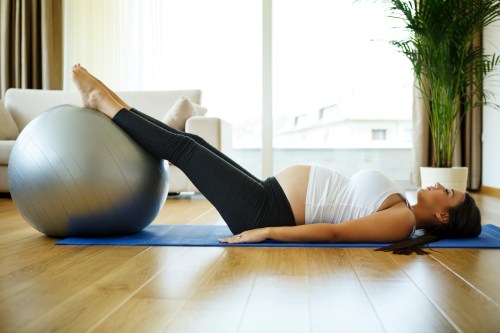8 Prenatal Pilates Exercises to Practice From the Comfort of Your Own Home
The 8 prenatal Pilates exercises that one fitness expert says are worth giving a try, so long as your physician has cleared you to exercise.

In the middle of the pandemic with gyms closed or at reduced capacity, working out while pregnant presents new challenges. Maybe you have a gym in your house or building, or maybe you are in a studio apartment. Maybe you haven’t exercised in a long time, or ever. If you’re unsure of what to do right now to support your body with movement while pregnant, know that you’re not alone.
There is a lot of misinformation about exercise and prenatal (and postnatal!) health. So before you tune in to a random exercise video, it’s important to know what kind of exercises are best for your body. As always, consult a doctor before starting any new exercise regimen, and if something doesn’t feel good, don’t do it.
A pregnant person’s body is working hard, all the time. The body has new physical demands as the baby grows bigger. Weight gain combined with hormonal changes and shifting one’s center of gravity increase the demands on the skeleton and postural muscles. A pregnant person’s heart rate is often higher and they have more blood circulating through their body; however, healthy exercise can support the body during pregnancy, minimize daily aches and pains, and help prepare for labor.
Still, there can (and should be) limitations to what you try during pregnancy. Avoid crunches, planking, high-impact exercise, and any exercise that activates the rectus abdominis, or puts additional pressure on the pelvic floor. Also, you should be able to comfortably speak and breathe while exercising. Don’t lay on your back, unless you feel fine to do so. Take breaks if you need them. Stay hydrated, and clear exercise with your physician always before trying something new (this workout included). Now, the main event: As a certified Pilates instructor, here are eight prenatal Pilates exercises that I like for you to try at home.
Transverse abdominis breathing
Our transverse abdominis or TVA, which is located in the side body, is among the most important core muscle to strengthen during pregnancy and postpartum. Use your TVA to support every exercise, and in your daily life to stabilize your spine. Practice by sitting up tall on your sitz bones. Inhale, fill your lungs. Exhale, hug your baby in with your abdominals. Repeat, adding a ‘Ssss’ sound as you exhale. Use your TVA hugging in, to send the ‘Ssss’ sound out. Repeat 25 times per day.
Pelvic tilts
Lying on your back, space your feet hip-width distance apart. Breathe, tuck your pelvis, lightly flattening your low back towards the mat, then un-tuck and arch your low back, restoring your lumbar curve. This is an extremely beneficial exercise for gently mobilizing a tight low back, and strengthening the low abdominals.
Bridging
Lie on your back. Tuck your pelvis. Roll your hips up off the mat. Pause at the top, squeezing your glutes, hamstrings, abdominals, and pelvic floor. Stay engaged as you articulate your spine back down to the mat, all the way to neutral. Repeat as often as you’d like.
Cat and cow
On your hands and knees, find your neutral spine. Inhale, arch your head and tail up towards the sky. Exhale, round your head and tail down towards the floor. Your ribcage moves in opposition. Hug your baby in with your TVA at all times.
Bird dog
On your hands and knees, lengthen your spine. Hug your baby with your deep core muscles. Extend your left leg back behind you on the mat, and reach your right arm forward. Alternate arms and legs. Keep your spine neutral, your core stable, and your pelvis balanced. Advance by lifting your leg in line with your spine.
Thread the needle
In quadruped (on your hands and knees), gently reach your left arm up toward the ceiling, follow your hand with your gaze. Then thread it underneath your right arm bringing your rib cage into a gentle twist. Repeat four times, on the last round, gently set your left shoulder, arm and head down, crawl your right arm over your ear. Breathe. Repeat on the other side.
Wall squat
Squat against a wall. Keep neutral spine alignment (not flat back), and your TVA engaged. Practice holding your wall squat for 30, 60, then 90 seconds to build strength and endurance.
Swan
Combat chest tightness and restricted breathing. Interlace your hands behind your low back. As you draw your knuckles down toward the floor, lift your chest up toward the ceiling. Breathe. Repeat often throughout your day.
Here’s a postnatal Pilates workout to try as well:
Oh hi! You look like someone who loves free workouts, discounts for cult-fave wellness brands, and exclusive Well+Good content. Sign up for Well+, our online community of wellness insiders, and unlock your rewards instantly.
Sign Up for Our Daily Newsletter
Get all the latest in wellness, trends, food, fitness, beauty, and more delivered right to your inbox.
Got it, you've been added to our email list.










